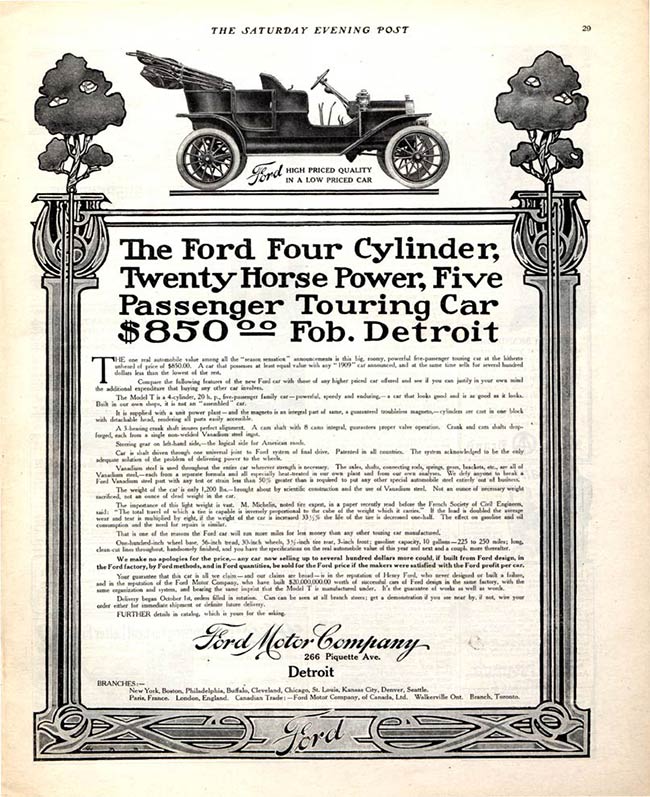Exploring Influential and Impactful Automotive Advertising Campaigns

A look at the past, present and future of disruptive marketing in the auto industry
Advertising has come a long way since its humble beginnings. There's no doubt about it – marketing remains an ever-changing landscape: What worked a few years ago may not be effective today, and what's popular now may be out of style in a few months. Nowhere is this more relevant than in the automotive industry, where new campaigns hold the potential to make or break a company. This article will explore some disruptive and impactful automotive marketing campaigns throughout the past century. We'll explore what made them successful and see how they changed the marketing landscape forever.
Early Automotive Marketing that Set the Stage
One of the earliest and most well-known automotive advertising campaigns was Ford's "Model T" campaign, successfully running from 1908 to 1927. The ads featured simple text and images that showed off the car's features and proved highly effective in launching the modern American motoring age. The Model T was a revolutionary car that changed the way people thought about transportation. Ford ran a full-page advertisement in the Saturday Evening Post in October 1908. The ad appealed to middle-income families with a bold headline, "Four-Cylinder, Twenty Horse Power, Five Passenger Touring Car" at just $850.00. The campaign was so successful that it helped make Ford one of the world's biggest and most successful automakers.
Innovation and Imagination Throughout the Decades
As time passed, new approaches to memorable and impactful marketing took shape, from General Motors' "See the USA in Your Chevrolet" campaign to Volkswagen's iconic "Think Small" approach. As the years continued, other approaches to disruptive automotive advertising blossomed. In the 1980s, we saw the first truly disruptive automotive marketing campaigns start to take shape. Automotive marketing teams needed to find new, innovative, and disruptive ways to capture the consumer's heart, imagination, and loyalty.
Saab ran an ad that featured a Saab car driving behind a jet with powerful slow-motion visuals and portrayed a lifestyle admirable to many. The tagline for the campaign was "Nothing on Earth comes close." Focused on the luxury and speed of the vehicle, the ad connected with an audience eager to experience a lifestyle they aspired to. This groundbreaking ad found tremendous success and launched the career of its director, who went on to direct the highly successful movie TOP GUN.
These early automotive campaigns were disruptive because they could reach a broad audience and promote their products in a very different way from what had been done before. They set the stage for automotive marketing campaigns that would come later and continue to be disruptive.
Toyota Breaks into the US Market
In the late 1960s and early 1970s, Toyota was relatively unknown in the United States. They had a small market share and were not considered a significant player in the automotive industry. However, that all began to change in the 1980s.
"In 1989, Toyota broke into the US market with the Lexus LS 400, a design icon at the time, and shook up the automotive industry with the vehicle and this commercial. The ad was so innovative, Nissan and Dodge copied it. In this commercial from 1989, The LS 400 is featured here at an equivalent of 145 miles per hour with 100 glasses of champagne featured on top without shattering. Toyota/Lexus was and still is a disruptor with every model they create," said Melanie Borden, Managing Member at Melanie Borden, LLC.
The mesmerizing Wine Glass commercial shot the Lexus LS into the stratosphere, becoming one of the most talked-about marketing campaigns of the year.
Captivating the Audience Once Line at a Time
Transitioning from big, bold headlines and visually stunning commercials cleverly designed to capture the attention of their target market, the next big disruptor in the automotive marketing industry took and more direct, singular approach. According to Dane Scott, President of Windstar Studios Inc., the simplicity of words scrolling across a screen boosted sales for dealerships on a global scale. "In my forty years of creating Tier 3 and Tier 2 automotive commercials, one, in particular, stands out: The Scroll. Words simply scrolling up the screen."
"The style gives it the appearance of breaking news, so you pay attention and almost have to read it. Dealers loved it, and it was effective, easy to produce, and affordable. I don't recall how many of these we made, but it was easily in the hundreds. From a personal perspective, the Super Bowl commercial that grabbed my attention the most was KIA's Robo Dog. Like many, I am teetering on the edge of going electric. Robo gave the commercial emotion and something to connect to. Plugging the dog into the EV to bring it back to life made the car a hero."
Moving Into the New Age
As the auto industry continues to evolve, disruptive marketing practices are becoming increasingly important and technologically advanced. As the auto industry has become more crowded and competitive, disruptive marketing practices have had to shift with technology booms, changing social- political beliefs, and a marketing landscape that has become entirely saturated. In the second part of this series, we will explore disruptive marketing in the auto industry throughout the past two decades, and learn how some companies have effectively broken through the noise to capture attention and find success.